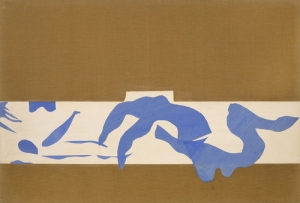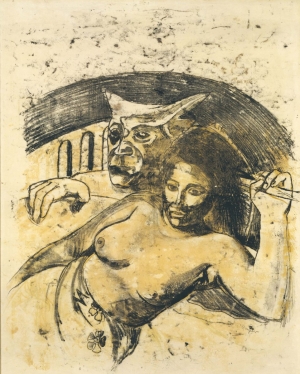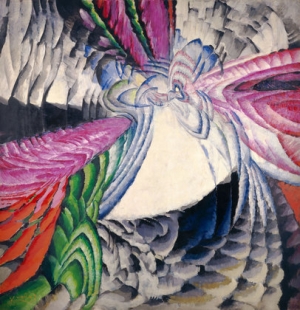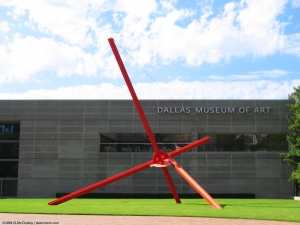|
Displaying items by tag: MOMA
The current Museum of Modern Art exhibition "One-Way Ticket: Jacob Lawrence’s Migration Series and Other Visions of the Great Movement North" expands uptown, beyond the Museum’s galleries, with the launch of a self-guided walking tour that explores the Harlem that nurtured Lawrence as a young artist in the 1930s. Featuring commentary from cultural leaders working there today, this audio tour puts Harlem’s past and present in dialogue. It is available beginning today at MoMA.org/harlemwalkingtour.
The tour introduces audiences to people and places that helped to shape Lawrence’s perspective as an artist, and visits artworks related to the exhibition that can only be seen at their locations in Harlem, such as Aaron Douglas’s landmark mural cycle at the Schomburg Center for Research in Black Culture and his mural at the YMCA on 135th Street; and Charles Alston’s recently restored murals at the Harlem Hospital Center.
On Easter 1939, Marian Anderson stood on the steps of the Lincoln Memorial in Washington and sang: “The gospel train is coming; I hear it just at hand; I hear the car wheels rumbling, and rolling through the land. Get on board.” By then, hundreds of thousands of African-Americans had already heard the call, leaving the rural South for the industrial North in search of jobs, homes and respect.
The same year she sang, the young artist Jacob Lawrence, son of relocated Southerners, began research for a sequence of paintings that would record the wave of boardings, rumblings and arrivals. Those paintings and journey itself are the subjects of “One-Way Ticket: Jacob Lawrence’s Migration Series and Other Visions of the Great Movement North” at the Museum of Modern Art, a show as stimulating to the mind and the ear as it is to the eye.
Pablo Picasso is best known for his paintings, bold works such as “Les Demoiselles d’Avignon” and “Guernica” that profoundly influenced the course of modern art.
This fall, the Museum of Modern Art plans to showcase a less-celebrated aspect of Picasso’s output—his sculpture—with a major survey of three-dimensional works that spans the artist’s entire career.
Featuring around 150 pieces from major collections around the world, “Picasso Sculpture” will run from Sept. 14, 2015 to Feb. 7, 2016.
It’s a small work of art — precisely the size of an old Savarin coffee can jammed with artist’s paintbrushes — but in the history of postwar art and in the career of Jasper Johns, one of the most important artists of the last half century, it looms large.
Created in 1960, “Painted Bronze” has been a fixture for more than three decades at the Philadelphia Museum of Art, where it has been on long-term loan from Mr. Johns’s personal collection. But now it will migrate north to a permanent home at the Museum of Modern Art, which will receive the sculpture as a promised gift from the collectors Henry R. Kravis and his wife, Marie-Josée Kravis, the Museum of Modern Art’s president, who recently bought it.
An Oscar Murillo canvas was taken from the exhibition “Forever Now: Painting in an Atemporal World" at MoMA last week by a visitor, a MoMA representative has officially confirmed.
"Last week, one was removed by a visitor," press director Margaret Doyle told artnet News in an email.
Doyle further claimed that MoMA security identified the visitor and it was "quickly returned without incident or damage to the work" and that all eight of the canvases by Murillo in the show "are on view in the galleries."
The Museum of Modern Art (MoMA) in New York has named Martino Stierli its new Philip Johnson Chief Curator of Architecture and Design. Stierli, who currently teaches the history of modern architecture at the University of Zurich, will begin at MoMA in March 2015. His duties will include overseeing the Department of Architecture and Design’s special exhibitions, installations from the collection, and acquisitions. Stierli succeeds Barry Bergdoll, who stepped down in 2013. Now a professor of art history and archaeology at Columbia University, Bergdoll continues to be a part-time curator at MoMA.
Stierli’s scholarly research has focused on a range of topics, including architecture and media, the photographic and cinematic portrayal of architecture, the intersection of art and architecture, the transatlantic exchange in postwar and postmodern architecture, and the role of travel in architectural education.

This fall, New York’s Museum of Modern Art (MoMA) will present a monumental exhibition devoted to Henri Matisse’s cut-outs. Late in his career, Matisse developed his cut-out technique, which involved cutting organic shapes out of painted sheets of paper and arranging them into lively compositions on his studio’s walls. The process gave Matisse a renewed sense of freedom and he lauded the technique for its immediacy and simplicity, which he believed helped him express his artistic urgencies more completely.
“Henri Matisse: The Cut-Outs” will be the largest and most extensive presentation of these unique works. The exhibition will present approximately 100 cut-outs -- borrowed from public and private collections around the world -- alongside a selection of related drawings, prints, illustrated books, stained glass, and textiles.
MoMA’s own Matisse cut-out, “The Swimming Pool,” recently underwent a multi-year conservation effort and will serve as a centerpiece of the exhibition. The cut-out, which was composed specifically for Matisse’s dining room in his apartment in France, was acquired by MoMA in 1975 and has been off view for over 20 years.
“Henri Matisse: The Cut-Outs” will be on view at the Museum of Modern Art from October 25, 2014 through February 8, 2015.

The Museum of Modern Art in New York is hosting “Gauguin: Metamorphoses,” the first major monographic exhibition on Paul Gauguin ever presented at the institution. It is also the first show to focus on the Post-Impressionist artist’s rare prints and transfer drawings and their relationship to his better-known paintings and sculptures.
“Gauguin: Metamorphoses,” which features nearly 130 works on paper and 30 related paintings and sculptures, includes loans from public and private collections. Between 1889 and his death in 1903, Gauguin created the prints in discrete bursts of activity. He experimented with woodcuts, watercolor monotypes and large transfer drawings and often repeated and recombined key motifs from one image to another, allowing them to evolve across mediums.
In order to highlight the relationships among works across mediums, the exhibition is organized loosely by date and groups related works together. The show starts with “Zincographs: The Volpini Suite,” which was created in 1889 and includes Gauguin’s first prints.The 11 zincographs were created on zinc plates rather than the traditional limestone slabs used for lithography, which is indicative of Gauguin’s unconventional artistic choices. “Woodcuts: The Noa Noa Suite and The Vollard Suite” includes Gauguin’s first woodcuts. The Noa Noa Suite was created between 1893 and 1894 after the artist’s first trip to Tahiti and ushered in the modern era with its distinctly rough and “primitive” style. The Vollard Suite, created between 1898 and 1899 after Gauguin returned to Tahiti for the second and final time, explores figures and themes from his earlier works and serves as an abbreviated retrospective of his career. Additional sections are devoted to the watercolor monotypes that Gauguin created around the time he was making the Noa Noa woodcuts, and his oil transfer drawings, which were made using a technique he invented in 1899.
“Gauguin: Metamorphoses” will be on view at MoMA through June 8, 2014.

Inventing Abstraction, 1910-1925 opened on December 23 at the Museum of Modern Art in New York and celebrates the bold art movement that swept across mediums and continents during the first half of the twentieth century. Severing ties with the realistic, practical images that dominated western art, abstraction infiltrated everything from sculpture and painting to poetry, music, and film.
Inventing Abstraction brings together over 350 works including paintings, stained glass, needlepoint, film, sculpture, and illustrated books. Organized by Leah Dickerman, a curator in MoMA’s painting and sculpture department, and Masha Chlenova, a curatorial assistant, the show includes many pieces that are on loan from outside museums.
Inventing Abstraction features works by Marsden Hartley (1877-1943), Marcel Duchamp (1887-1968), Piet Mondrian (1872-1944), Wassily Kandinsky (1866-1944), and many others. While extremely comprehensive, the exhibition draws connections between artists and illustrates the development of abstraction over time.

The Dallas Museum of Art announced today that it will nullify its $10 general admission fee, effective January 21, 2013. The museum will also launch an online rewards program that could even make membership free.
In recent years, many institutions have reversed their decision to charge visitors and are now free to the public. The Nelson-Atkins Museum of Art in Kansas City, Missouri, the Indianapolis Museum of Art, the Baltimore Museum of Art, the Walters Museum of Art in Baltimore, and the Detroit Institute of the Arts have all decided that free admission will help their institutions become more widely accessible, which, in turn, will keep visitor numbers up.
While it appears that the aforementioned museums have started a trend, many institutions in major tourist destinations are not so quick to jump on the free entry bandwagon. In New York, the Museum of Modern Art charges $25 and the Guggenheim Museum charges $22. San Francisco’s Museum of Modern Art, another major tourist attraction, charges $18. Other big-name museums that require visitors to pay are the Los Angeles County Museum of Art, the Art Institute of Chicago, the Philadelphia Museum of Art, and the Carnegie Museum of Art.
|
|
|
|
|